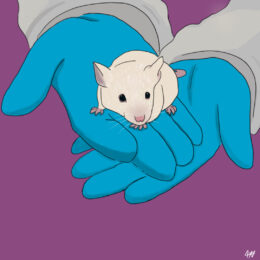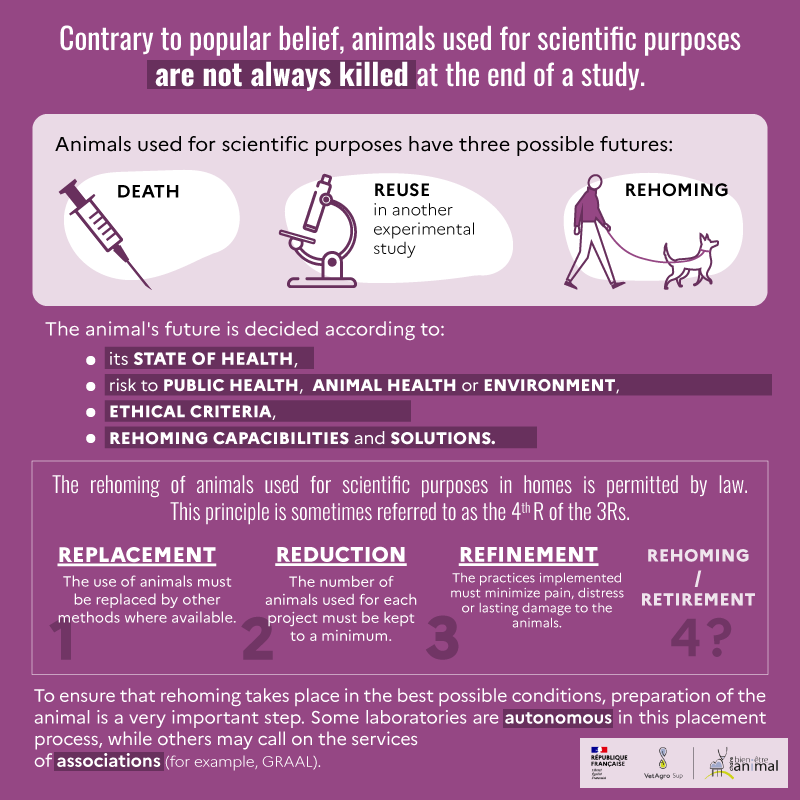

FALSE
Contrary to popular belief, animals used for scientific purposes are not always killed at the end of a study. In fact, European and French regulations authorize the rehoming of such animals under certain conditions.
Keep in mind
- Legislation allows the rehoming of animals used for scientific purposes
- This practice is sometimes referred to as the 4th R of the 3Rs rule
- The number of animals rehomed remains unknown for the moment. However, the rehoming procedure has been simplified and the practice encouraged by legislation.
Find out more in this video report, followed by a text!
What happens to animals used for scientific purposes?
A wide variety of studies involve animals: basic research studies, toxicological and regulatory studies, applied research, studies aimed at species preservation… Not all studies are invasive, and some may even simply involve testing the palatability of a new animal feed before it is marketed.
Each scientific project involving the use of animals must be submitted for authorization to the French Ministry of Higher Education, Research and Innovation (MESRI), after validation from the ethics committee to which the applicant institution is attached. Project authorizations must mention the number of animals involved, as well as the fate of the animals at the end of the project.
Animals used for scientific purposes have three possible futures:
- Death
- Reuse in another experimental study
- Rehoming
This is decided on the basis of an animal’s state of health, the risk to public health, various ethical criteria, and also in view of the other available outcomes.

Did you know?
For the time being, no source can give a precise figure for the rate of rehomed animals.
Various surveys provide figures on the species of animals used, the type of studies conducted, the severity of the procedures, and the number of animals reused in other studies. However, these investigations give no information on the number of animals rehomed and, to our knowledge, there is no source that provides information on the placement rate to date. LThe GRAAL association, which places animals used for scientific purposes, reports that more than 6,000 animals have been rehomed via their services since they began operations in 2005[1].
Legislation that allows the placement of animals for welfare reasons
The placement in foster homes (also sometimes referred to as rehoming or retirement) of animals used for scientific purposes is allowed under the following regulations[2]. These regulations aim for a “total replacement of procedures applied to live animals for scientific and educational purposes, as soon as scientifically possible“. In other words, the objective is to replace the use of animals for scientific purposes with non-animal alternatives as soon as possible. Alternatives must be reliable and validated for each scientific study. Various techniques have already been developed (e.g. use of in vitro models) to reduce the number of animals used.
For scientific studies with no alternative, regulations govern the use of animals and their placement under certain conditions. Depending on the species concerned (pets: dogs, cats, rodents, etc.; farm animals: cows, sheep, etc.; wild animals: primates, etc.), this may be in a foster home, a breeding system adapted to the species, a refuge, or in their natural habitat for certain wild species.
Certain conditions must be met:
- The animal’s state of health must allow it to be placed,
- There must be no danger to public health, animal health or the environment (e.g. the animal must not have been infected with a transmissible pathogen),
- Appropriate measures must exist to safeguard the animal’s welfare[3].
Furthermore, to spare the animals “unnecessary distress“, “guarantee public safety” and ensure the success of the operation, research facilities wishing to place animals must have a socialization or rehabilitation program in place in the case of wild animals released into their habitat[4].
Laboratory animal rehoming: the 4th R?
The rehoming of animals used for scientific purposes is a principle that is added to the 3R rule (Replacement, Reduction, Refinement), and is sometimes considered as a 4th R.
The 3R rule was developed in 1959 by Russell and Burch.
- Replacement : the use of animals should be replaced by other methods whenever possible, without compromising the quality of the research.
- Reduction : the number of animals used for each project must be reduced as much as possible, while still achieving the desired objectives.
- Refinement : the practices implemented (rearing conditions, housing, care, methods used) must minimize any lasting pain, suffering, anguish or damage that the animals may experience.

Did you know?
According to an Ipsos survey published in 2021:
- 5% of French people say they know the 3R rule (replace, reduce, refine)
- 11% of French people say they know exactly which animal experimentation ethics committees and structures are responsible for animal welfare.
The French population does not seem to know much about the regulations that protect animals used for scientific purposes.
How is rehoming carried out and supervised?
To ensure that placement takes place under the best possible conditions, preparation of the animal is a very important step. Laboratory housing conditions are very particular indeed, and despite many efforts to enrich and socialize the animals, the laboratory environment is often quite different from the environment the animal will experience after rehoming, and the new situations it will encounter. Preparing the animal for its placement ensures that it goes as smoothly as possible. For example, for future rehoming, dogs can be taught the basics of dog training, such as how to walk on a leash, to ease the transition into their new lives.
Within each research facility, the Animal Welfare Body (AWB, in French SBEA) is responsible for advising on animal placement programs. The AWB is a mandatory structure under European Directive 2010/63/EU and Decree 2013-118 (article R. 214-103 of the French Rural Code).

Did you know?
Each AWB must include at least the laboratory's animal welfare officer (AWO), with advice from the laboratory's designated veterinarian. The AWB must also include at least one person who has been trained in animal experimentation best practices for the design or implementation of experimental procedures.
In addition to their advisory role for animal rehoming programs, these structures are responsible for advising staff on animal care and the application of the 3Rs, as well as establishing and reviewing internal operational procedures, monitoring project progress and results, and exchanging information with project managers (potential project modifications).
In France, the placement or release of animals that have been used for scientific purposes may be authorized by the prefect of the department in which the animals are placed or released (Art R214-112 of the Code rural et de la pêche maritime). ). In practice, the laboratory must submit a request to the DDPP (Direction Départementale de la Protection des Populations) overseeing the laboratory, which will then liaise with the DDPP receiving the animals.
Some associations work to place animals used for scientific purposes. For instance, GRAAL, which has helped to place hundreds of animals. To help laboratories with the rehoming process, GRAAL, in partnership with the Direction Générale de l’Alimentation (DGAl), has produced a Manual for the retirement of laboratory animals. GRAAL is not a reception center, but acts as a facilitator between the various stakeholders involved, helping to place animals used for scientific purposes. GRAAL assists laboratories in their efforts to rehome animals, and selects suitable foster homes for them. Animals may be set up directly for adoption (by individuals), placed in shelters run by other animal protection associations (e.g. SPA) while waiting to be adopted by families, or in specialized shelters that allow certain species to be placed (e.g. La Hardonnerie).
If you would like to adopt an animal that has been used for scientific purposes, please visit the GRAAL website, which will put you in touch with nearby shelters!
Some laboratories are autonomous in their placement procedures from start to finish, and do not go through the intermediary of an association. This is the case, for example, of Biovivo, a research laboratory located on the VetAgro Sup site, which regularly put animals up for adoption, initially through Vetagro Sup’s communication networks. Many animals (dogs, cats, horses, etc.) have already been adopted. Moreover, unlike GRAAL, which has chosen to give priority to institutions (SPA and other shelters), Biovivo systematically reaches out to temporary foster families (most of the time VetAgro Sup students) for dogs before offering them for adoption.
In conclusion
Finally, although it is yet not possible to dispense with the use of animals to achieve certain new scientific results, many efforts are being made, on various levels, to take better care of their welfare. Some of them can even be rehomed and given a new life after their use in the laboratory. Beyond improvements in laboratory living conditions and the possibilities for rehoming animals used for scientific purposes, the long-term aim is to dispense with their use altogether.
In short
[1]A figure put forward by Marie-Françoise Lheureux in her interview
[2]« Directive 2010/63/UE du Parlement européen et du Conseil du 22 septembre 2010 relative à la protection des animaux utilisés à des fins scientifiques» (transposed into regulation in 2013)
[3] « Article R214-112 – Code rural et de la pêche maritime – Légifrance »
[4] « Article R214-112 – Code rural et de la pêche maritime – Légifrance »
Keep in mind
- Legislation allows the rehoming of animals used for scientific purposes
- This practice is sometimes referred to as the 4th R of the 3Rs rule
- The number of animals rehomed remains unknown for the moment. However, the rehoming procedure has been simplified and the practice encouraged by legislation.
Key Figure
An animal used for scientific purposes has three possible futures: death, reuse in another experimental study and rehoming.

The French Rural Code provides a real incentive – through the bodies in charge of animal welfare, and each time a protocol is put in place – to think about the possibility of giving animals a second life.

SAMUEL VIDAL, Head of animal welfare at Biovivo


